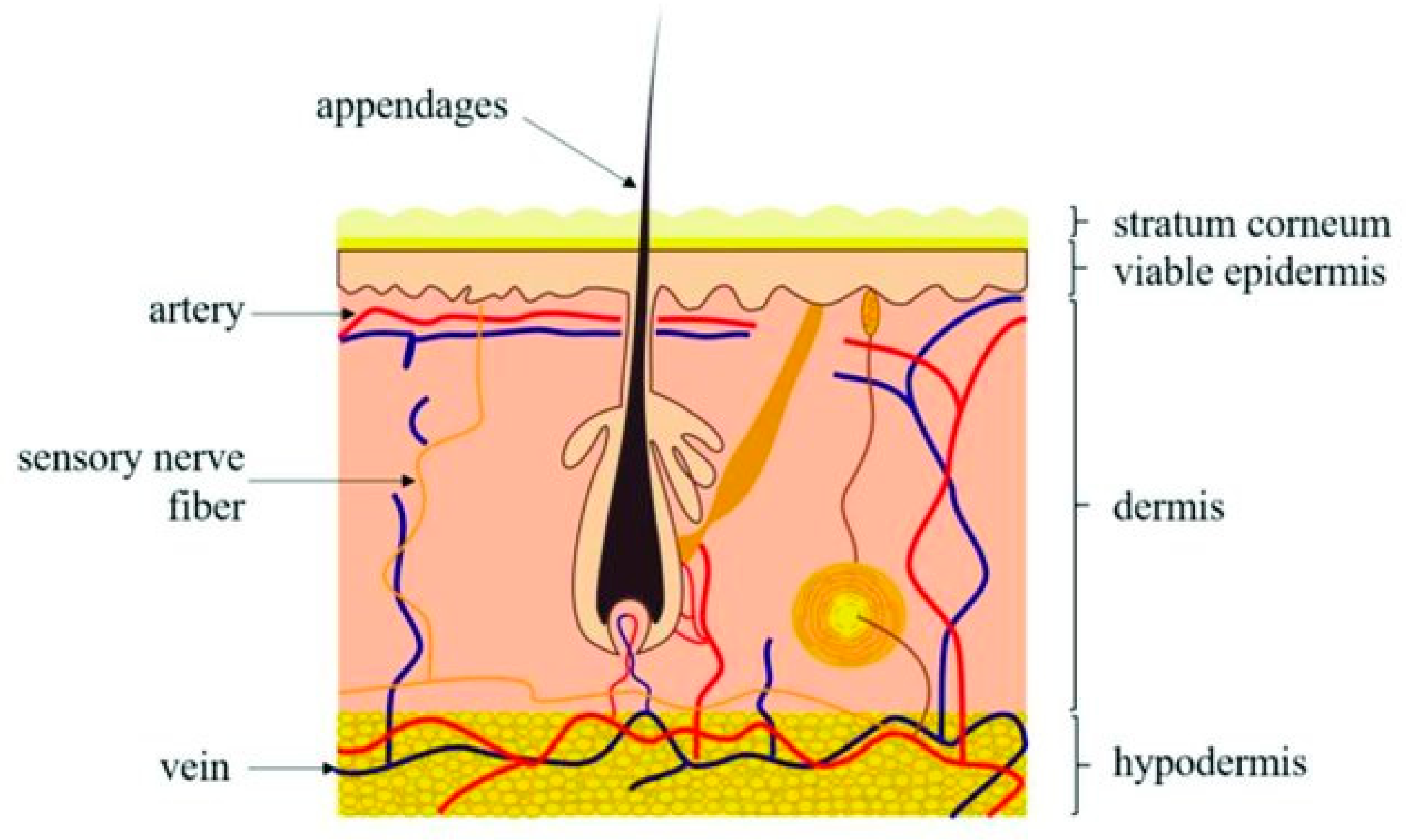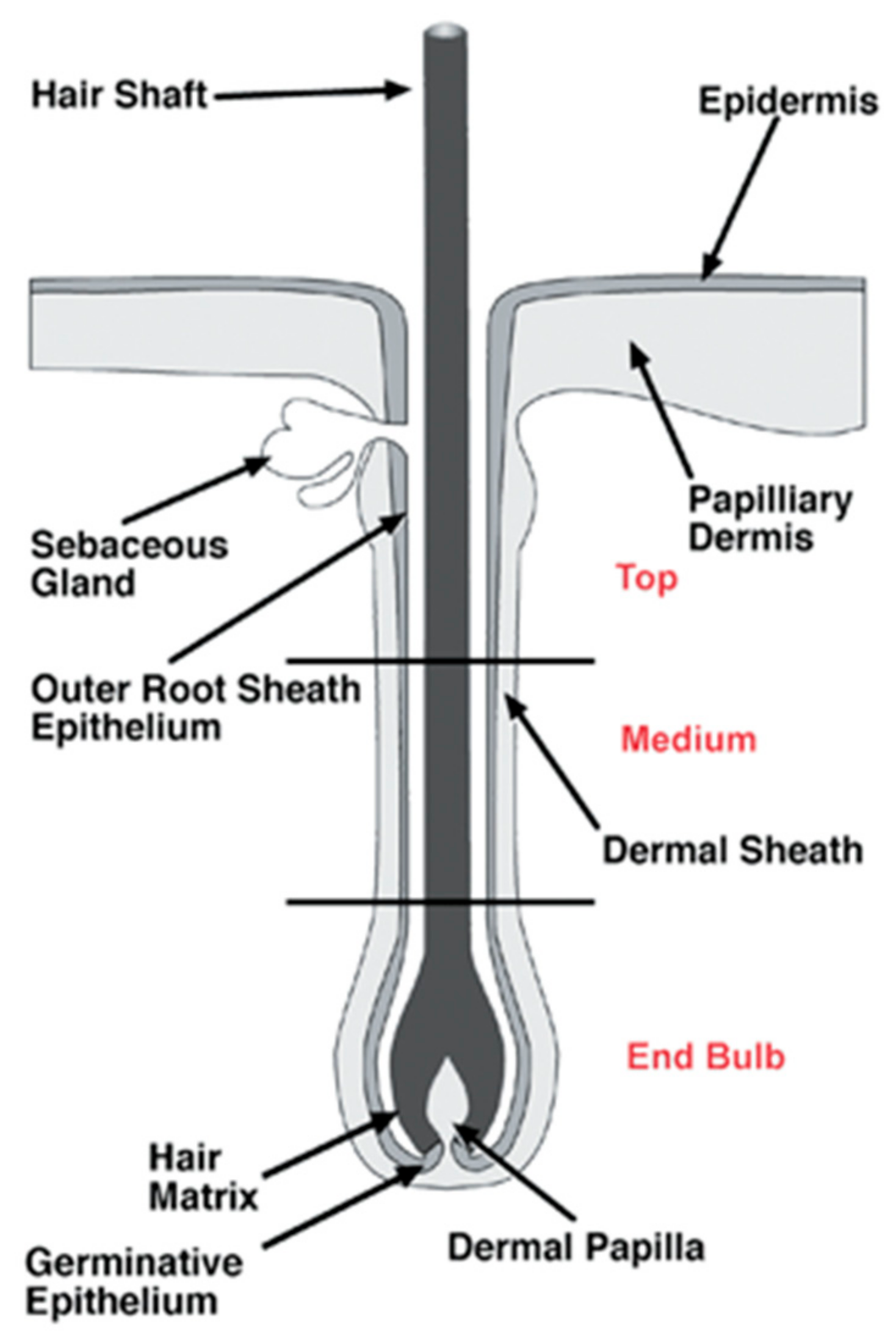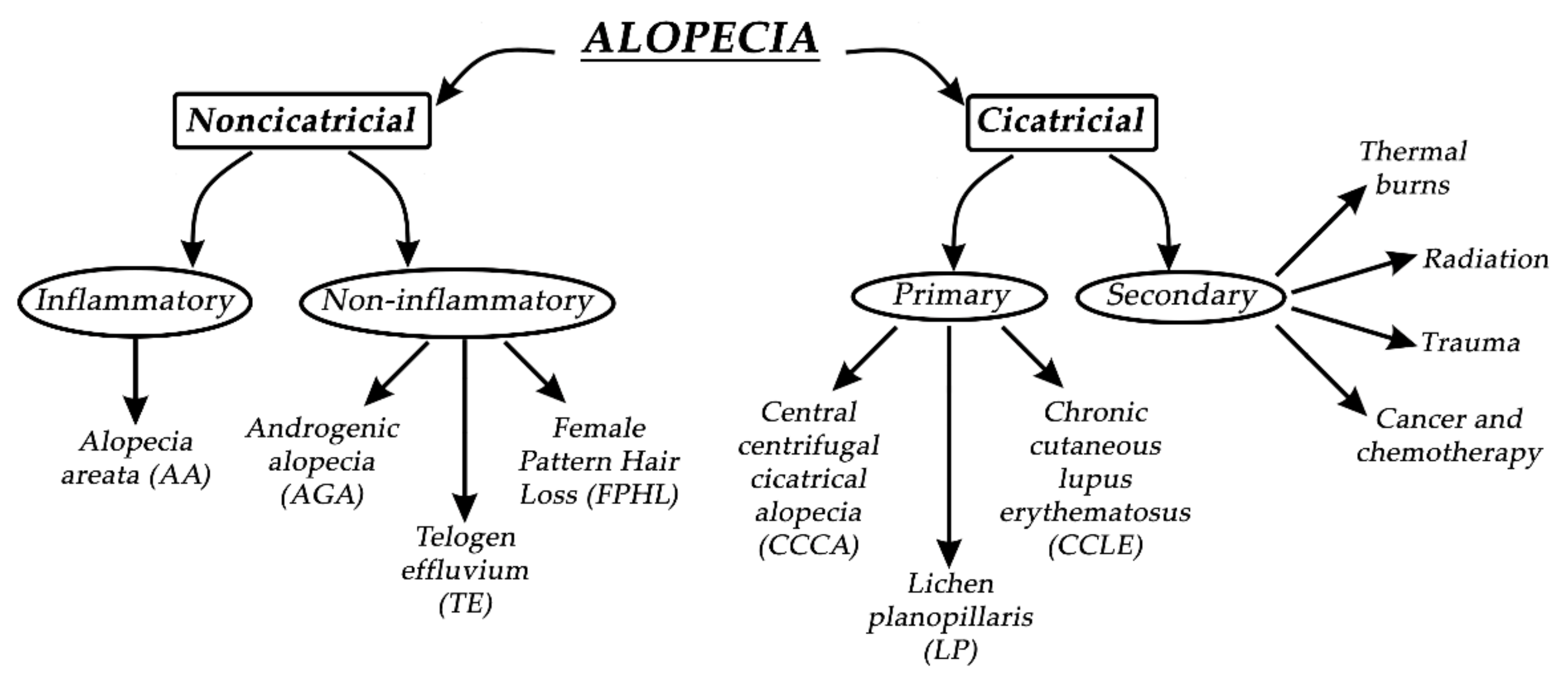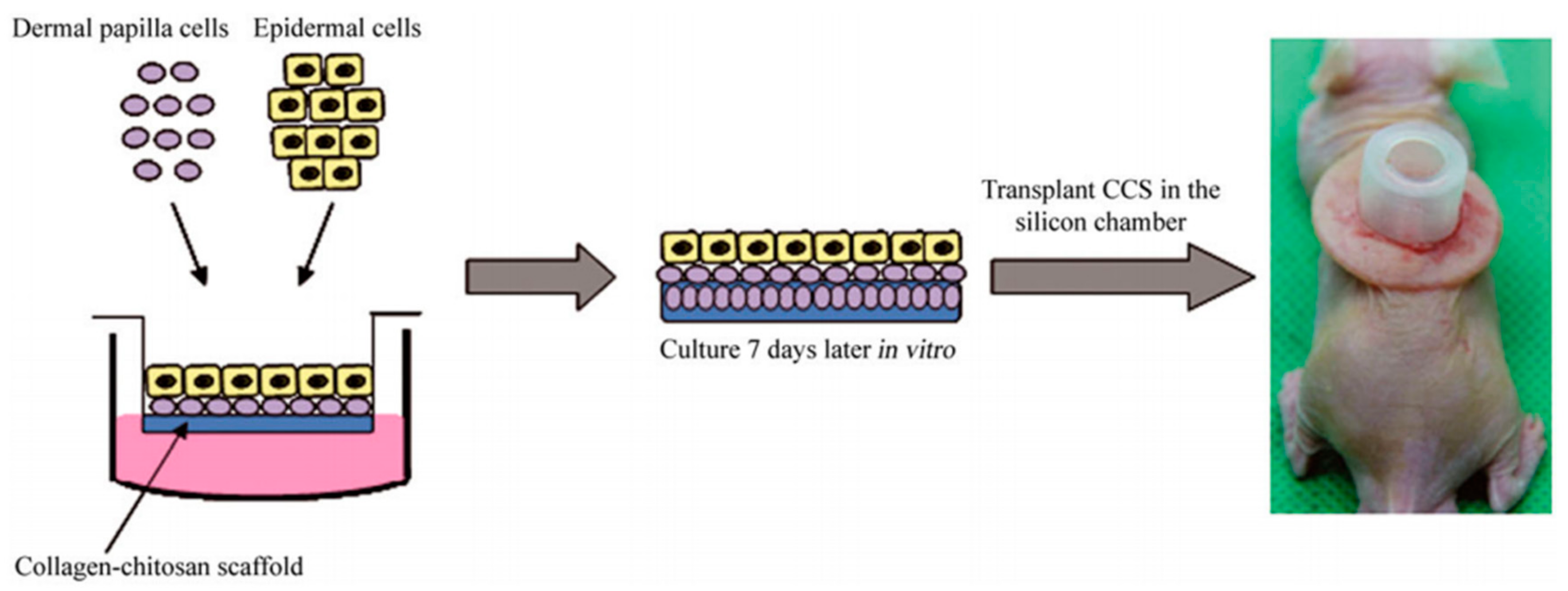Design of In Vitro Hair Follicles for Different Applications in the Treatment of Alopecia—A Review
Abstract
:1. Introduction
2. Materials and Methods
3. Skin Morphology with Emphasis on the Hair Follicle
Hair Follicle Cycle
4. Hair Loss
5. In Vitro Growth of Hair Follicles
5.1. Cells for the Development of In Vitro HF Models
5.2. Materials for In Vitro HF Models
6. Application of In Vitro Hair Follicles
6.1. In Vitro Models and Assays for Evaluating Effects of Active Compounds on Alopecia and Hair Growth
6.2. Applications of In Vitro Hair Follicles in Hair Transplantation
7. Concluding Remarks and Outlook
Author Contributions
Funding
Institutional Review Board Statement
Informed Consent Statement
Data Availability Statement
Acknowledgments
Conflicts of Interest
Abbreviations
| HF | Hair follicle |
| MPHL | Male pattern hair loss |
| FPHL | Female pattern hair loss |
| IFE | Interfollicular epidermis |
| DP | Dermal papilla |
| DPC | Dermal papilla cell |
| DPT | Dermal papilla tissue |
| HG | Hair germ |
| HL | Hair loss |
| PCA | Primary cicatricial alopecia |
| SCA | Secondary cicatricial alopecia |
| CCLE | Chronic cutaneous lupus erythematosus |
| CCCA | Central centrifugal cicatricial alopecia |
| AA | Alopecia areata |
| AGA | Androgenic alopecia |
| SE | Skin equivalent |
| HFOC | Hair follicle organ culture |
| ECM | Extracellular matrix |
| ssHFG | Self-sorted hair follicle germ |
| ORSK | Outer root skin keratinocyte |
| hiPSC | Human-induced pluripotent stem cell |
| SKP | Skin-derived precursor |
| HFSC | Hair follicle stem cell |
| HDF | Human dermal fibroblast |
| PEGDA | Poly(ethylene glycol) diacrylate |
| EVAL | Ethylene vinyl alcohol |
| ACD | Contact allergic dermatitis |
| DPRA | Direct peptide reactivity assay |
| hTERT | Human telomerase reverse transcriptase |
| HSC | Human skin construct |
| DEC | Dermal–epidermal composites |
| MHC | Major histocompatibility class |
| TSA | Trichostatin A |
| HSV | Hemivascularized sandwich |
References
- Nistico, S.; Tamburi, F.; Bennardo, L.; Dastoli, S.; Schipani, G.; Caro, G.; Fortuna, M.C.; Rossi, A. Treatment of telogen effluvium using a dietary supplement containing Boswellia serrata, Curcuma longa, and Vitis vinifera: Results of an observational study. Dermatol. Ther. 2019, 32, e12842. [Google Scholar] [CrossRef]
- Kalabusheva, E.P.; Chermnykh, E.S.; Terskikh, V.V.; Vorotelyak, E.A. Hair Follicle Reconstruction and Stem Cells. In Hair and Scalp Disorders; InTech, 2017. [Google Scholar] [CrossRef] [Green Version]
- Watt, F.M. Mammalian skin cell biology: At the interface between laboratory and clinic. Science 2014, 346, 937. Available online: http://science.sciencemag.org/content/346/6212/937.abstract (accessed on 12 January 2021). [CrossRef]
- Ventrelli, L.; Strambini, L.M.; Barillaro, G. Microneedles for Transdermal Biosensing: Current Picture and Future Direction. Adv. Health Mater. 2015, 4, 2606–2640. [Google Scholar] [CrossRef]
- Millar, S.E. Molecular Mechanisms Regulating Hair Follicle Development. J. Investig. Dermatol. 2002, 118, 216–225. [Google Scholar] [CrossRef]
- Yang, C.-C.; Cotsarelis, G. Review of hair follicle dermal cells. J. Dermatol. Sci. 2010, 57, 2–11. [Google Scholar] [CrossRef] [PubMed] [Green Version]
- Nakamura, M.; Schneider, M.R.; Schmidt-Ullrich, R.; Paus, R. Mutant laboratory mice with abnormalities in hair follicle morphogenesis, cycling, and/or structure: An update. J. Dermatol. Sci. 2013, 69, 6–29. Available online: http://europepmc.org/abstract/MED/23165165 (accessed on 18 December 2020). [CrossRef]
- Huelsken, J.; Vogel, R.; Erdmann, B.; Cotsarelis, G.; Birchmeier, W. β-Catenin Controls Hair Follicle Morphogenesis and Stem Cell Differentiation in the Skin. Cell 2001, 105, 533–545. [Google Scholar] [CrossRef] [Green Version]
- Choi, S.-J.; Cho, A.-R.; Jo, S.-J.; Hwang, S.T.; Kim, K.H.; Kwon, O.S. Effects of glucocorticoid on human dermal papilla cells in vitro. J. Steroid Biochem. Mol. Biol. 2013, 135, 24–29. [Google Scholar] [CrossRef]
- Korosec, A.; Lichtenberger, B.M. In vitro models to study hair follicle generation. Skin Tissue Models Regen. Med. 2018, 279–301. [Google Scholar] [CrossRef]
- Schneider, M.R.; Schmidt-Ullrich, R.; Paus, R. The Hair Follicle as a Dynamic Miniorgan. Curr. Biol. 2009, 19, R132–R142. [Google Scholar] [CrossRef] [PubMed] [Green Version]
- Gareri, J.; Koren, G. Prenatal hair development: Implications for drug exposure determination. Forensic Sci. Int. 2010, 196, 27–31. [Google Scholar] [CrossRef] [PubMed]
- Driskell, R.R.; Clavel, C.; Rendl, M.; Watt, F.M. Hair follicle dermal papilla cells at a glance. J. Cell Sci. 2011, 124, 1179–1182. [Google Scholar] [CrossRef] [PubMed] [Green Version]
- Reis, R.L. Encyclopedia of Tissue Engineering and Regenerative Medicine Elsevier Science. 2019. Available online: https://books.google.si/books?id=h2RjvgEACAAJ (accessed on 14 October 2020).
- Lako, M.; Armstrong, L.; Cairns, P.M.; Harris, S.; Hole, N.; Jahoda, C.A.B. Hair Follicle Dermal Cells Repopulate the Mouse Haematopoietic System. J. Cell Sci. 2002, 115, 3967–3974. Available online: http://jcs.biologists.org/content/115/20/3967.abstract (accessed on 15 June 2020). [CrossRef] [PubMed] [Green Version]
- Oh, J.W.; Kloepper, J.; Langan, E.A.; Kim, Y.; Yeo, J.; Kim, M.J.; Hsi, T.C.; Rose, C.; Yoon, G.S.; Lee, S.J.; et al. A Guide to Studying Human Hair Follicle Cycling In Vivo. J. Investig. Dermatol. 2016, 136, 34–44. [Google Scholar] [CrossRef] [Green Version]
- Paus, R.; Cotsarelis, G. The Biology of Hair Follicles. N. Engl. J. Med. 1999, 341, 491–497. [Google Scholar] [CrossRef] [Green Version]
- Cotsarelis, G.; Millar, S.E. Towards a molecular understanding of hair loss and its treatment. Trends Mol. Med. 2001, 7, 293–301. [Google Scholar] [CrossRef]
- Hsu, Y.-C.; Pasolli, H.A.; Fuchs, E. Dynamics between Stem Cells, Niche, and Progeny in the Hair Follicle. Cell 2011, 144, 92–105. Available online: https://pubmed.ncbi.nlm.nih.gov/21215372 (accessed on 14 July 2020). [CrossRef] [PubMed] [Green Version]
- Hardy, M.H. The secret life of the hair follicle. Trends Genet. 1992, 8, 55–61. Available online: https://www.sciencedirect.com/science/article/abs/pii/016895259290350D (accessed on 23 April 2020). [CrossRef]
- Wang, X.; Tredget, E.E.; Wu, Y. Dynamic Signals for Hair Follicle Development and Regeneration. Stem Cells Dev. 2012, 21, 7–18. [Google Scholar] [CrossRef] [PubMed]
- Shapiro, J. Hair Loss: Principles of Diagnosis and Management of Alopecia. Taylor & Francis, 2001. Available online: https://books.google.si/books?id=ijn6wAEACAAJ (accessed on 17 September 2020).
- Ebbell, B. The Papyrus Ebers: The Greatest Egyptian Medical Document; Levin & Munksgaard; Oxford University Press: London, UK, 1937. [Google Scholar]
- Owczarczyk-Saczonek, A.; Krajewska-Włodarczyk, M.; Kruszewska, A.; Banasiak, Ł.; Placek, W.; Maksymowicz, W. Therapeutic Potential of Stem Cells in Follicle Regeneration. Stem Cells Int. 2018, 2018, 1049641. Available online: https://pubmed.ncbi.nlm.nih.gov/30154860 (accessed on 17 October 2020). [CrossRef] [PubMed] [Green Version]
- Vary, J.C., Jr. Selected Disorders of Skin Appendages—Acne, Alopecia, Hyperhidrosis. Med. Clin. N. Am. 2015, 99, 1195–1211. [Google Scholar] [CrossRef] [PubMed]
- Mirmirani, P.; Willey, A.; Headington, J.T.; Stenn, K.; McCalmont, T.H.; Price, V.H. Primary cicatricial alopecia: Histo-pathologic findings do not distinguish clinical variants. J. Am. Acad. Dermatol. 2005, 52, 637–643. [Google Scholar] [CrossRef]
- Harries, M.J.; Sinclair, R.D.; Macdonald-Hull, S.; Whiting, D.A.; Griffiths, C.E.; Paus, R. Management of primary cicatricial alopecias: Options for treatment. Br. J. Dermatol. 2008, 159, 1–22. [Google Scholar] [CrossRef] [PubMed]
- Harries, M.J.; Paus, R. The Pathogenesis of Primary Cicatricial Alopecias. Am. J. Pathol. 2010, 177, 2152–2162. [Google Scholar] [CrossRef] [PubMed]
- Hassan, A.S. Surgical treatment of secondary cicatricial alopecia of scalp and eyebrow. Indian J. Plast. Surg. 2009, 42, 63–67. Available online: https://pubmed.ncbi.nlm.nih.gov/19881023 (accessed on 14 October 2020). [CrossRef] [PubMed]
- Olsen, E.A.; Bergfeld, W.F.; Cotsarelis, G.; Price, V.H.; Shapiro, J.; Sinclair, R.; Solomon, A.; Sperling, L.; Stenn, K.; Whiting, D.A. Summary of North American Hair Re-search Society (NAHRS)-sponsored Workshop on Cicatricial Alopecia, Duke University Medical Center, February 10 and 11, 2001. J. Am. Acad. Dermatol. 2003, 48, 103–110. [Google Scholar] [CrossRef] [PubMed]
- Whiting, D.A. Cicatricial alopecia: Clinico-pathological findings and treatment. Clin. Dermatol. 2001, 19, 211–225. [Google Scholar] [CrossRef]
- Filbrandt, R.; Rufaut, N.; Jones, L.; Sinclair, R. Primary cicatricial alopecia: Diagnosis and treatment. Can. Med. Assoc. J. 2013, 185, 1579–1585. [Google Scholar] [CrossRef] [Green Version]
- Darwin, E.; Hirt, P.A.; Fertig, R.; Doliner, B.; Delcanto, G.; Jimenez, J.J. Alopecia Areata: Review of Epidemiology, Clinical Features, Pathogenesis, and New Treatment Options. Int. J. Trichol. 2018, 10, 51–60. Available online: https://pubmed.ncbi.nlm.nih.gov/29769777 (accessed on 20 May 2020). [CrossRef] [PubMed]
- Qi, J.; Garza, L.A. An Overview of Alopecias. Cold Spring Harb. Perspect. Med. 2014, 4, a013615. [Google Scholar] [CrossRef] [PubMed]
- Hordinsky, M.K. Medical Treatment of Noncicatricial Alopecia. Semin. Cutan. Med. Surg. 2006, 25, 51–55. [Google Scholar] [CrossRef]
- Hughes, E.C.; Saleh, D. Telogen Effluvium. In StatPearls; StatPearls Publishing: Treasure Island, FL, USA, 2021. [Google Scholar]
- Randall, V.A.; Sundberg, J.P.; Philpott, M.P. Animal and in vitro models for the study of hair follicles. In Journal of Investigative Dermatology Symposium Proceedings; Blackwell Publishing Inc.: Hoboken, NJ, USA, 2003; pp. 39–45. [Google Scholar] [CrossRef] [Green Version]
- Choi, S.; Zhang, B.; Ma, S.; Gonzalez-Celeiro, M.; Stein, D.; Jin, X.; Kim, S.T.; Kang, Y.-L.; Besnard, A.; Rezza, A.; et al. Corticosterone inhibits GAS6 to govern hair follicle stem-cell quiescence. Nat. Cell Biol. 2021, 1–5. [Google Scholar] [CrossRef]
- Higgins, C.A.; Richardson, G.D.; Ferdinando, D.; Westgate, G.E.; Jahoda, C.A. Modelling the hair follicle dermal papilla using spheroid cell cultures. Exp. Dermatol. 2010, 19, 546–548. [Google Scholar] [CrossRef]
- Langan, E.A.; Philpott, M.P.; Kloepper, J.E.; Paus, R. Human hair follicle organ culture: Theory, application and perspectives. Exp. Dermatol. 2015, 24, 903–911. [Google Scholar] [CrossRef] [PubMed]
- Kwack, M.H.; Yang, J.M.; Won, G.H.; Kim, M.K.; Kim, J.C.; Sung, Y.K. Establishment and characterization of five immor-talized human scalp dermal papilla cell lines. Biochem. Biophys. Res. Commun. 2018, 496, 346–351. [Google Scholar] [CrossRef]
- Topouzi, H.; Logan, N.J.; Williams, G.; Higgins, C.A. Methods for the Isolation and 3D Culture of Dermal Papilla Cells from Human Hair Follicles; Blackwell Publishing Ltd.: Hoboken, NJ, USA, 2017; Volume 26, pp. 491–496. [Google Scholar] [CrossRef]
- Soma, T.; Tajima, M.; Kishimoto, J. Hair cycle-specific expression of versican in human hair follicles. J. Dermatol. Sci. 2005, 39, 147–154. [Google Scholar] [CrossRef] [PubMed]
- Miao, Y.; Bin Sun, Y.; Liu, B.C.; Jiang, J.D.; Hu, Z.Q. Controllable Production of Transplantable Adult Human High-Passage Dermal Papilla Spheroids Using 3D Matrigel Culture. Tissue Eng. Part A 2014, 20, 2329–2338. [Google Scholar] [CrossRef] [PubMed] [Green Version]
- Gupta, A.C.; Chawla, S.; Hegde, A.; Singh, D.; Bandyopadhyay, B.; Lakshmanan, C.C.; Kalsi, G.; Ghosh, S. Establishment of an in vitro organoid model of dermal papilla of human hair follicle. J. Cell. Physiol. 2018, 233, 9015–9030. [Google Scholar] [CrossRef] [PubMed]
- Lee, L.F.; Chuong, C.M. Building Complex. Tissues: High. Throughput Screening for Molecules Required in Hair Engineering; Nature Publishing Group: Berlin, German, 2009; Volume 129, pp. 815–817. [Google Scholar] [CrossRef] [Green Version]
- Lin, B.; Miao, Y.; Wang, J.; Fan, Z.; Du, L.; Su, Y.; Liu, B.; Hu, Z.; Xing, M. Surface Tension Guided Hanging-Drop: Producing Controllable 3D Spheroid of High-Passaged Human Dermal Papilla Cells and Forming Inductive Microtissues for Hair-Follicle Re-generation. ACS Appl. Mater. Interfaces 2016, 8, 5906–5916. [Google Scholar] [CrossRef] [PubMed]
- Kageyama, T.; Yoshimura, C.; Myasnikova, D.; Kataoka, K.; Nittami, T.; Maruo, S.; Fukuda, J. Spontaneous hair follicle germ (HFG) formation in vitro, enabling the large-scale production of HFGs for regenerative medicine. Biomaterials 2018, 154, 291–300. [Google Scholar] [CrossRef] [PubMed]
- Tan, J.J.Y.; Common, J.E.; Wu, C.; Ho, P.C.L.; Kang, L. Keratinocytes maintain compartmentalization between dermal pa-pilla and fibroblasts in 3D heterotypic tri-cultures. Cell Prolif. 2019, 52. [Google Scholar] [CrossRef] [PubMed] [Green Version]
- Abaci, H.E.; Coffman, A.; Doucet, Y.; Chen, J.; Jacków, J.; Wang, E.; Guo, Z.; Shin, J.U.; Jahoda, C.A.; Christiano, A.M. Tissue engineering of human hair follicles using a biomimetic developmental approach. Nat. Commun. 2018, 9, 1–11. [Google Scholar] [CrossRef] [PubMed]
- Zhang, X.; Xiao, S.; Liu, B.; Miao, Y.; Hu, Z. Use of extracellular matrix hydrogel from human placenta to restore hair-inductive potential of dermal papilla cells. Regen. Med. 2019, 14, 741–751. [Google Scholar] [CrossRef]
- Ohyama, M.; Kobayashi, T.; Sasaki, T.; Shimizu, A.; Amagai, M. Restoration of the intrinsic properties of human dermal papilla in vitro. J. Cell Sci. 2012, 125, 4114–4125. [Google Scholar] [CrossRef] [PubMed] [Green Version]
- Havlíčková, B.; Biro, T.; Mescalchin, A.; Arenberger, P.; Paus, R. Towards optimization of an organotypic assay system that imitates human hair follicle-like epithelial-mesenchymal interactions. Br. J. Dermatol. 2004, 151, 753–765. [Google Scholar] [CrossRef] [PubMed]
- Huang, Y.C.; Chan, C.C.; Lin, W.T.; Chiu, H.Y.; Tsai, R.Y.; Tsai, T.H.; Chan, J.Y.; Lin, S.J. Scalable production of controllable dermal papilla spheroids on PVA surfaces and the effects of spheroid size on hair follicle regeneration. Biomaterials 2013, 34, 442–451. [Google Scholar] [CrossRef] [PubMed]
- Lin, C.-M.; Li, Y.; Ji, Y.-C.; Huang, K.; Cai, X.-N.; Li, G.-Q. Induction of hair follicle regeneration in rat ear by microencapsulated human hair dermal papilla cells. Chin. J. Traumatol. 2009, 12, 49–54. [Google Scholar]
- Dong, L.; Hao, H.; Liu, J.; Tong, C.; Ti, D.; Chen, D.; Chen, L.; Li, M.; Liu, H.; Fu, X.; et al. Wnt1a maintains characteristics of dermal papilla cells that induce mouse hair regeneration in a 3D preculture system. J. Tissue Eng. Regen. Med. 2015, 11, 1479–1489. [Google Scholar] [CrossRef]
- Gnedeva, K.; Vorotelyak, E.; Cimadamore, F.; Cattarossi, G.; Giusto, E.; Terskikh, V.V.; Terskikh, A.V. Derivation of Hair-Inducing Cell from Human Pluripotent Stem Cells. PLoS ONE 2015, 10, e0116892. [Google Scholar] [CrossRef] [Green Version]
- Lindner, G.; Horland, R.; Wagner, I.; Ataç, B.; Lauster, R. De novo formation and ultra-structural characterization of a fiber-producing human hair follicle equivalent in vitro. J. Biotechnol. 2011, 152, 108–112. Available online: https://www.sciencedirect.com/science/article/pii/S0168165611000630?via%3Dihub (accessed on 18 April 2020). [CrossRef]
- Castro, A.R.; Logarinho, E. Tissue Engineering Strategies for Human Hair Follicle Regeneration: How Far from a Hairy Goal? John Wiley and Sons Ltd.: Hoboken, NJ, USA, 2020; Volume 9, pp. 342–350. [Google Scholar]
- Takagi, R.; Ishimaru, J.; Sugawara, A.; Toyoshima, K.-E.; Ishida, K.; Ogawa, M.; Sakakibara, K.; Asakawa, K.; Kashiwakura, A.; Oshima, M.; et al. Bioengineering a 3D integumentary organ system from iPS cells using an in vivo transplantation model. Sci. Adv. 2016, 2, e1500887. Available online: http://advances.sciencemag.org/content/2/4/e1500887.abstract (accessed on 4 July 2020). [CrossRef] [PubMed] [Green Version]
- Yen, C.M.; Chan, C.C.; Lin, S.J. High-throughput reconstitution of epithelial-mesenchymal interaction in fol-liculoid microtissues by biomaterial-facilitated self-assembly of dissociated heterotypic adult cells. Biomaterials 2010, 31, 4341–4352. [Google Scholar] [CrossRef] [PubMed]
- Tan, J.J.Y.; Nguyen, D.-V.; Common, J.E.; Wu, C.; Ho, P.C.L.; Kang, L. Investigating PEGDA and GelMA Microgel Models for Sustained 3D Heterotypic Dermal Papilla and Keratinocyte Co-Cultures. Int. J. Mol. Sci. 2021, 22, 2143. [Google Scholar] [CrossRef] [PubMed]
- Almeida, A.; Sarmento, B.; Rodrigues, F. Insights on In Vitro Models for Safety and Toxicity Assessment of Cosmetic In-Gredients; Elsevier, B.V.: Amsterdam, The Netherlands, 2017; Volume 519, pp. 178–185. [Google Scholar]
- Madaan, A.; Verma, R.; Singh, A.T.; Jaggi, M. Review of Hair Follicle Dermal Papilla Cells as In Vitro Screening Model. for Hair Growth; Blackwell Publishing Ltd.: Hoboken, NJ, USA, 2018; Volume 40, pp. 429–450. [Google Scholar] [CrossRef] [Green Version]
- Abbott, A. The lowdown on animal testing for cosmetics. Nature 2009. [Google Scholar] [CrossRef]
- Bataillon, M.; Lelièvre, D.; Chapuis, A.; Thillou, F.; Autourde, J.B.; Durand, S.; Boyera, N.; Rigaudeau, A.S.; Besné, I.; Pellevoisin, C. Characterization of a New Recon-structed Full Thickness Skin Model, T-SkinTM, and its Application for Investigations of Anti-Aging Compounds. Int. J. Mol. Sci. 2019, 20, 2240. [Google Scholar] [CrossRef] [PubMed] [Green Version]
- Morris, R.J.; Liu, Y.; Marles, L.; Yang, Z.; Trempus, C.; Li, S.; Lin, J.S.; Sawicki, J.A.; Cotsarelis, G. Capturing and profiling adult hair follicle stem cells. Nat. Biotechnol. 2004, 22, 411–417. [Google Scholar] [CrossRef] [PubMed]
- Randall, M.J.; Jüngel, A.; Rimann, M.; Wuertz-Kozak, K. Advances in the Biofabrication of 3D Skin in vitro: Healthy and Pathological Models. Front. Bioeng. Biotechnol. 2018, 6, 154. Available online: https://pubmed.ncbi.nlm.nih.gov/30430109 (accessed on 25 May 2020). [CrossRef] [PubMed] [Green Version]
- Horland, R.; Lindner, G.; Wagner, I.; Atac, B.; Hoffmann, S.; Gruchow, M.; Sonntag, F.; Klotzbach, U.; Lauster, R.; Marx, U. Human hair follicle equivalents in vitro for transplantation and chip-based substance testing. BMC Proc. 2011, 5, O7. [Google Scholar] [CrossRef] [PubMed] [Green Version]
- Zheng, Y.; Du, X.; Wang, W.; Boucher, M.; Parimoo, S.; Stenn, K.S. Organogenesis From Dissociated Cells: Generation of Mature Cycling Hair Follicles From Skin-Derived Cells. J. Investig. Dermatol. 2005, 124, 867–876. [Google Scholar] [CrossRef] [PubMed] [Green Version]
- Lim, T.C.; Leong, M.F.; Lu, H.; Du, C.; Wan, A.C.A. Can an in vitro hair drug model be developed using dermal papilla cells alone? Exp. Dermatol. 2021. [Google Scholar] [CrossRef] [PubMed]
- Marazzi, M.; Crovato, F.; Bucco, M.; Sironi, M.C.; Tosca, M.C.; Antonioli, B.; Chlapanidas, T.; Lucconi, G.; Rapisarda, V.; Scalise, A.; et al. GMP-Compliant Culture of Human Hair Follicle Cells for Encapsulation and Transplantation. Cell Transplant. 2012, 21, 373–378. [Google Scholar] [CrossRef] [PubMed]
- Thangapazham, R.L.; Klover, P.; Wang, J.-A.; Zheng, Y.; Devine, A.; Li, S.; Sperling, L.C.; Cotsarelis, G.; Darling, T.N. Dissociated Human Dermal Papilla Cells Induce Hair Follicle Neogenesis in Grafted Dermal–Epidermal Composites. J. Investig. Dermatol. 2014, 134, 538–540. [Google Scholar] [CrossRef] [PubMed] [Green Version]
- Wu, X.; Scott, L.; Washenik, K.; Stenn, K. Full-thickness skin with mature hair follicles generated from tissue culture expanded human cells. Tissue Eng. Part A 2014, 20, 3314–3321. [Google Scholar] [CrossRef] [PubMed]
- Leirós, G.J.; Kusinsky, A.G.; Drago, H.; Bossi, S.; Sturla, F.; Castellanos, M.L.; Stella, I.Y.; Balañá, M.E. Dermal Papilla Cells Improve the Wound Healing Process and Generate Hair Bud-Like Structures in Grafted Skin Substitutes Using Hair Follicle Stem Cells. Stem Cells Transl. Med. 2014, 3, 1209–1219. [Google Scholar] [CrossRef] [PubMed]
- Paus, R.; Ito, N.; Takigawa, M.; Ito, T. The Hair Follicle and Immune Privilege. J. Investig. Dermatol. Symp. Proc. 2003, 8, 188–194. [Google Scholar] [CrossRef] [PubMed]
- Kinori, M.; Kloepper, J.E.; Paus, R. Can the hair follicle become a model for studying selected aspects of human ocular immune privilege? Investig. Ophthalmol. Vis. Sci. 2011, 52, 4447–4458. [Google Scholar] [CrossRef] [PubMed]
- Guo, L.; Wang, X.; Yuan, J.; Zhu, M.; Fu, X.; Xu, R.H.; Wu, C.; Wu, Y. TSA restores hair follicle-inductive capacity of skin-derived precursors. Sci. Rep. 2019, 9, 1–10. [Google Scholar] [CrossRef]
- Biernaskie, J.; Paris, M.; Morozova, O.; Fagan, B.M.; Marra, M.; Pevny, L.; Miller, F.D. SKPs Derive from Hair Follicle Precursors and Exhibit Properties of Adult Dermal Stem Cells. Cell Stem Cell 2009, 5, 610–623. [Google Scholar] [CrossRef] [Green Version]
- Hsieh, C.-H.; Wang, J.-L.; Huang, Y.-Y. Large-scale cultivation of transplantable dermal papilla cellular aggregates us-ing microfabricated PDMS arrays. Acta Biomater. 2011, 7, 315–324. [Google Scholar] [CrossRef] [PubMed]
- Biernaskie, J. Human Hair Follicles: “Bulging” with Neural Crest–Like Stem Cells. J. Investig. Dermatol. 2010, 30, 1202–1204. Available online: http://www.sciencedirect.com/science/article/pii/S0022202X15348223 (accessed on 20 June 2020). [CrossRef] [PubMed] [Green Version]
- Qiao, J.; Turetsky, A.; Kemp, P.; Teumer, J. Hair morphogenesis in vitro: Formation of hair structures suitable for im-plantation. Regen. Med. 2008, 3, 683–692. [Google Scholar] [CrossRef] [PubMed]
- Aoi, N.; Inoue, K.; Kato, H.; Suga, H.; Higashino, T.; Eto, H.; Doi, K.; Araki, J.; Iida, T.; Katsuta, T.; et al. Clinically applicable transplantation procedure of dermal papilla cells for hair follicle regeneration. J. Tissue Eng. Regen. Med. 2011, 6, 85–95. [Google Scholar] [CrossRef] [PubMed]
- Kageyama, T.; Nanmo, A.; Yan, L.; Nittami, T.; Fukuda, J. Effects of platelet-rich plasma on in vitro hair follicle germ preparation for hair regenerative medicine. J. Biosci. Bioeng. 2020, 130, 666–671. Available online: https://www.sciencedirect.com/science/article/pii/S1389172320303042 (accessed on 15 September 2020). [CrossRef] [PubMed]







| Model | Main results | Advantages | Limitations | Reference |
|---|---|---|---|---|
| Spheroid-like 3D cultures | Expression of β-catenin | The ability to restore expression of the markers confirmed by methods such as RT-PCR and immunofluorescence. | Higher costs | [42,46,47] |
| Monolayer 2D hair follicle models | Adherent DPCs cultured on plastic (2D-style HF model) barely expressed NCAM, versican, and a-SMA proteins | Ease of use, lower cost, and abundant scientific literature surrounding its use | Loss of primary inductive potency of dermal papilla cell (DPC); do not show expression of markers associated with HF inductivity | [43,44] |
| Animal models | The best model to study HF cycling | A better understanding of pathophysiological processes involved in alopecia | Ethical limitations, human HF growth phases differ in comparison to animals, and growth does not occur in synchronized manner | [45,46] |
| DPC in microwells | Overexpressing the MR gene Lef-1 in combination with spontaneous DPC spheroid formation in the HSCs showed a significant increase (from 19% to 70%) in the success rate of ex vivo HF formation compared to empty vector-transfected DPCs. | A physiological arrangement of cells in a hair follicle | Difficulties with appropriate selection of growth factors, small molecules, or proliferation enhancers; limitation by resolution in the spatial control of cells | [50] |
Publisher’s Note: MDPI stays neutral with regard to jurisdictional claims in published maps and institutional affiliations. |
© 2021 by the authors. Licensee MDPI, Basel, Switzerland. This article is an open access article distributed under the terms and conditions of the Creative Commons Attribution (CC BY) license (https://creativecommons.org/licenses/by/4.0/).
Share and Cite
Žnidarič, M.; Žurga, Ž.M.; Maver, U. Design of In Vitro Hair Follicles for Different Applications in the Treatment of Alopecia—A Review. Biomedicines 2021, 9, 435. https://doi.org/10.3390/biomedicines9040435
Žnidarič M, Žurga ŽM, Maver U. Design of In Vitro Hair Follicles for Different Applications in the Treatment of Alopecia—A Review. Biomedicines. 2021; 9(4):435. https://doi.org/10.3390/biomedicines9040435
Chicago/Turabian StyleŽnidarič, Matej, Žan Michel Žurga, and Uroš Maver. 2021. "Design of In Vitro Hair Follicles for Different Applications in the Treatment of Alopecia—A Review" Biomedicines 9, no. 4: 435. https://doi.org/10.3390/biomedicines9040435
APA StyleŽnidarič, M., Žurga, Ž. M., & Maver, U. (2021). Design of In Vitro Hair Follicles for Different Applications in the Treatment of Alopecia—A Review. Biomedicines, 9(4), 435. https://doi.org/10.3390/biomedicines9040435







